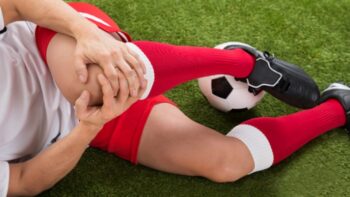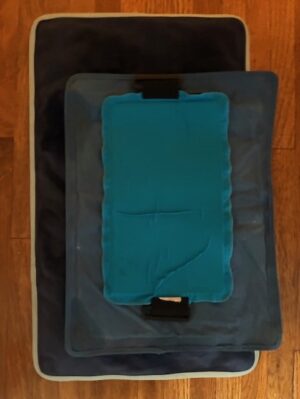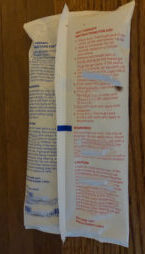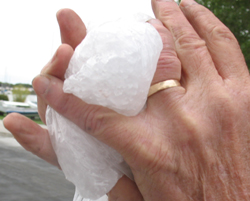Note to on-line users not in my classes: this is a study sheet. It is not complete instruction in first aid. In a formal class you will learn steps for recognizing emergencies, how and when to call 911, protecting yourself, (including how to obtain consent and prevent disease transmission), how to prioritize care and much more. A formal class will give you more details than this webpage.
BASIC STEPS FOR CONTROLLING non-life threatening EXTERNAL BLEEDING
CHECK the scene for safety. Quickly evaluate- location, problems, dangers, number of victims, behavior of victims/bystanders, need for additional assistance
Check the injured person, following standard precautions. (Put on your personal protective equipment, at least gloves, and in some cases a face mask/bandanna, glasses/goggles, gown.)
CALL 9-1-1 or the local emergency number if necessary.
To CARE for a person who is bleeding—
STEP 1
Obtain Consent Before Providing Care, keep getting consent as you do new things
Identify yourself
State level of training
Explain what you observe, why you think help is needed
Explain what you plan to do
If you did not do so before this, put on your personal protective equipment (at least gloves, and in some cases a face mask/bandanna, glasses/goggles, gown)
Cover the wound with a dressing. To minimize the chances of infection this bandage/gauze should be sterile.
(Do not use kleenex, toilet paper, cotton puffs that can disintegrate into the wound and would need to be cleaned out.)
STEP 2
Apply direct pressure, hard and steady, until bleeding stops. (Since the pressure you put on the wound needs to be hard, instead of pushing on another student’s forearm for example, we use a (quoting from the instructors manual) “simulation device for bleeding control (e.g. pool noodle).” You will push on the pool noodle and bandage it.
You should apply pressure for at least 5 minutes before taking your hand off the dressing to see if the pressure worked.
(In the meanwhile, carefully remove rings, etc. that could cut off circulation if swelling occurs. But do not remove parts of clothing or jewelry that are attached to burn wounds.)
If you use a hemostatic dressing, remember, to stay effective, hemostatic dressings require continuous direct pressure at the source of the bleeding until controlled.
STEP 3
Cover dressings with a roller bandage. Tie or tape it in place. As appropriate, check fingers or toes for feeling, warmth and color to insure the bandage is not too tight.
If bleeding does not stop—
(if you have not yet, this could be an important time to call 911)
.. Apply an additional dressing. Do not remove the first dressing as it can disrupt the formation of a clot and re-start bleeding.
.. Take steps to minimize shock.
Note: Wash hands with soap and water after giving care, even if you are sure the gloves you wore fully protected you.
open wound types:
Abrasion (scrape – most common type of open wound)
Laceration (cut)
Avulsion (portion of the skin torn away)
Puncture
Will this wound require stitches?
A good rule of thumb is, “If you think the wound needs stitches, it probably does.”
Stitches will probably be needed if:
the edges of the skin do not fall together, the wound gapes open, and/or jagged edges that gape open
the laceration involves parts of the body where scarring could impair function (as in the feet, hands or joints)
or appearance (as in a conspicuous scar on the face if the wound were left un-stitched)
any wound that is deep or over 1/2 inch long
Some first aid supply stores sell suture kits, others recommend crazy glue. They are not needed, even out in the field / wilderness, and improperly closing a would can cause a dangerous, even life threatening infection. Leave closure of wounds gaping over 1/2 inch to a health care provider.
The manufacturer says “Krazy Glue products should not be used for wound care.”
– – – – – – – – – – – – – – – – – – – – – – – – – – – – – – – – – – – – – – – – – –
The CDC (Centers for Disease Control) offers this about wound care after a disaster
“The risk for injury during and after a hurricane and other natural disasters is high. Flood waters and standing waters pose various risks, including infectious diseases, chemical hazards and injuries . . . Avoid contact with flood waters if you have an open wound.”
“Seek immediate medical care if a wound develops redness, swelling, or oozing or other signs of working infection such as fever, increasing pain, shortness of breath, fast heart rate, or confusion or disorientation, high heart rate.”
“Seek medical attention as soon as possible if:
• There is a foreign object (soil, wood, metal, or other objects) embedded in the wound;
• A wound is a result of an animal bite;
• A wound is a result of a puncture by a dirty object;
• The wound is infected (pain and soreness, swelling, redness, draining, or you develop a fever);
• You have signs of sepsis such as confusion or disorientation, shortness of breath, high heart rate, fever or shivering, extreme pain or discomfort or clammy or sweaty skin.”
“If you have wounds, you should be evaluated for a tetanus immunization. If you receive a puncture wound or a wound contaminated with feces, soil, or saliva, have a health care professional determine whether a tetanus booster is necessary based on individual records.”
“Take care of wounds:
• Wash your hands thoroughly with soap and clear water, if possible.
• Avoid touching the wound with your fingers while treating it (if possible, use disposable gloves).
• Remove obstructive jewelry and clothing from the injured body part.
• Apply direct pressure to any bleeding wound to control bleeding.
• Clean the wound after bleeding has stopped.
Examine wounds for dirt and foreign objects.
Gently flood the wound with bottled water or clean running water (if available, saline solution is preferred).
Gently clean around the wound with soap and clean water.
Pat dry and apply an adhesive bandage or dry clean cloth.
• Leave unclean wounds, bites and punctures open. Wounds that are not cleaned correctly can trap bacteria and result in infection.
• Provide pain relievers when possible.
• Review the wound every 24 hours.”
– – – – – – – – – – – – – – – – – – – – – – – – – – – – – – – – – – – – – – – – – –
Signs and Symptoms of Shock
Restlessness/irritability
Rapid/weak pulse
Rapid breathing
Pale, ashen, or bluish/cool/moist skin
Excessive thirst
Nausea and vomiting
Drowsiness/loss of consciousness
Signs and symptoms of internal bleeding
…Signs and Symptoms of Shock above and:
tender, swollen, bruised area of the body
sometimes bruising is not visible on the surface, put the area feels hard
vomiting or coughing up blood
becoming faint, drowsy, confused
unconscious
An accident victim often needs 4-40 units of red blood cells, but people in our area generally do not donate enough blood.
Read about donating at: Blood donation FAQs

Treatment for closed soft tissue injuries ( sprains, strains, bruises . . .),
(RICE)
Rest to allow clots to form. Do not move or straighten the area. Avoid movement that causes pain.
Immobilization
Cold: apply plastic bag of ice (with a thin barrier between the ice and skin) 20 minutes on, 20 minutes off, or as instructed by your doctor
Elevate above heart level unless it causes more pain
You can buy, and store in the freezer, various sizes of freezable and or microwavable reusable warm and/or cold compresses.
The three shown below are 21 inches x 13 inches, 15 inches x 11.5 inches and 12 inches x 7 inches.

Note that the compresses above have rounded corners.
A typical gel pack (10 inches x 5 inches, with instructions for use printed on the bag), shown below has sharp corners and could be improved by carefully trimming the corners so they are rounded and less likely to poke to person or poke through the soft cloth you would wrap it in before use.

Always follow the manufacturer’s (or those of a medical professional / doctor) instructions for safe use. Safe use instructions could include time limits on using them (number of minutes at a time), who should consult a doctor before using them, adult supervision when used by a child, ways to test the pack before use to be sure it is the proper temperature, how to clean, and more.
Expect that they will eventually leak.
Anticipate swelling and remove jewelry.

(The man in the photo above did not want a thin barrier between the ice bag and his already swollen finger.)
Signs of wound infection
(Older adults are at higher risk for wound infection.)
pain does not get better a few days after the injury, or actually gets worse
increasing pain, swelling, tenderness or warmth
small pimple over the wound
swelling beyond what might be considered normal for that wound
pus (with or without a foul odor) coming from the wound (usually thick, varies from white to pink to yellow or light green); pus increasing and growing darker in color.
redness spreading from around the edges of the wound, progressing to red streaks extending from the wound up a limb towards the heart
advanced: chills and fever, swollen glands in the groin, armpit or neck, nausea
(Especially watch punctures for early signs of infection.)
EYE INJURY
For an object embedded in the eye—
.. DO NOT attempt to remove an object embedded in the eye.
.. Place a sterile dressing around the object in the eye; stabilize dressing around the objects in the eye; stabilize the object, such as with a paper cup, for support.
.. Bandage loosely and do not put pressure on the injured eye/eyeball.
.. Seek immediate medical attention.
For small foreign bodies in the eye such as sand or other small debris—
.. Tell the person to blink several times to try to remove the object.
.. Gently flush the eye with clean-enough-to-drink water.
.. Seek medical attention if the object remains.
For chemicals in the eye—
.. Flush the eye continuously with clean-enough-to-drink water for at least 20 minutes or until EMS personnel arrive.
Always flush away from the uninjured eye.
Severed Body Parts Call 911
.. Control bleeding. see BASIC STEPS FOR CONTROLLING EXTERNAL BLEEDING above
you should let the EMT do these next steps, but if no professional help is available:
.. Wrap and bandage the wound to prevent infection.
.. If bleeding is significant, give care to minimize shock.
.. Wrap the severed body part in sterile gauze or a clean cloth.
.. Place the severed body part in a plastic bag.
.. Put the plastic bag on ice (but do not freeze it)
.. Be sure it is taken to the hospital with the victim, since doctors might be able to reattach it
Nosebleed
.. Have the person sit leaning slightly forward.
.. Pinch the nostrils together for about 10 minutes.
.. Alternatively, apply an ice pack to the bridge of the nose, but do not damage skin tissue by applying it directly to the skin.
Do not pack the person’s nose with cotton, tissues, (or anything) to stop the bleeding.
If bleeding does not stop—
.. Apply pressure on the upper lip just beneath the nose.
.. Send someone to call 9-1-1 or the local emergency number if the person loses consciousness; position the person on the side to allow blood to drain from the nose.
Note: Seek medical attention if the bleeding persists or recurs or if the person says it results from high blood pressure
After the bleeding stops—
.. Have the person avoid rubbing, blowing or picking the nose, which could restart the bleeding.
Injuries to the Abdomen
for these severe injuries Call 911
If organs are exposed in an open wound—
.. Do not apply pressure to organs or push them back inside.
.. Keep the person lying down with his or her knees bent, if that position does not cause pain.
.. Put a folded blanket or pillow under the knees to support them in this position.
.. Carefully remove any clothing from around the wound.
.. Loosely apply moist, sterile dressings or a clean cloth over the wound. (Warm tap water can be used to wet the dressing.)
.. If available, loosely cover this dressing with plastic wrap
.. Place a cloth over the dressing to keep organs warm.
.. Give care to minimize shock.
If organs are not exposed—
.. Keep the person lying down with knees bent, if that position does not cause pain.
.. Put a folded blanket or pillow under the knees to support the person in this position.
.. Give care to minimize shock.
Care for Muscle and Bone Injuries
- Rest to allow clots to form
Immobilize
Cold: apply a plastic bag of ice (with a thin barrier between the ice and skin)
Elevate above heart level unless it causes more pain
BASICS of SPLINTING
.. Splint an injury only if the person must be moved;
.. Splint an injury only if it can be done without causing the person more pain or discomfort;
.. Splint an injured limb in the position you find it; and
.. A splint should immobilize the areas above and below the site of the injury.
CHECK the scene for safety.
Check the injured person following standard precautions.
Call 911 or the local emergency number if necessary.
The first steps to CARE for a person who has an injured limb—
STEP 1
Obtain consent.
Support the injured area above and below the site of the injury.
STEP 2 Check for feeling, warmth and color. (If you are not able to check warmth and color because a sock or shoe is in place, check for feeling.)
Common Signs and Symptoms of Musculoskeletal Injuries
Pain
Bruising and swelling
Significant deformity
Discoloration
Bone protruding from wound (if part of the bone is protruding through the skin,
do not attempt to align/straighten the bone or place the bones back into the body.)
Inability to use affected part normally
Grating bones
Heard a napping or popping sound
Cause of injury, such as fall from height, suggests that the injury may be severe
BURNS
Types of Burns
Superficial (first-degree)
Partial-thickness (second-degree)
Full-thickness (third-degree)
Critical Burns (you do not need to call 911 for every burn, but for critical burns you do need to call)
Burns causing breathing difficulty;
The depth of the burn;
The percentage of the body’s surface area that is burned; (more than one body part, or a large percentage of the person’s total body area and circumferential burns – those that go all the way around a limb)
the location of the burn; (hands, feet or groin / genitals, head, neck or mouth;
the age of the person; (younger than 5 years or older than 60 years, unless the burn is very minor)
the cause of the burn (electricity, exposure to chemicals, exposure to nuclear radiation, or an explosion)
Electrical shock may cause burns inside the body, so be sure the person is taken to a doctor.
Suspected burns to the airway (burns to the mouth and nose may be a sign of this)
Your palm (or another source says palm and fingers) is approximately 1% of your body surface, use this to estimate extent of burns.
Care for thermal (heat) Burns
- Stop the burning by removing the person from the source of heat
Cool burned area with cool water
Cover burned area with a sterile dressing
Take steps to minimize shock
Keep the victim from getting chilled or overheated
Anticipate swelling and carefully remove rings, etc. that could cut off circulation if swelling occurs. But do not remove parts of clothing or jewelry that are attached to burn wounds.)
Don’t touch burns, break blisters, or remove burned clothing
![]() What to put in a First Aid Kit
What to put in a First Aid Kit
– – – – – – – – – – – – – – – – – – – – – – – – – – – – – – – – – – –
see also:
Times to suspect a spinal injury (symptoms, causes, signs of spinal injury)
How to pass a Red Cross written test
Bloodborne Pathogens quick facts
first aid Secondary Assessment
causes of fainting, altered mental status, sudden altered mental status, unconsciousness
Seizures, causes of and basic care for
Concussion signs and symptoms, prevention
————————————————-
The author of this webpage, (written as a homework reading assignment for my students), does not give any warranty, expressed or implied, nor assume any legal liability or responsibility for the accuracy, completeness, or usefulness of any information, product, or process included in this website or at websites linked to or from it. Users of information from this website assume all liability arising from such use.